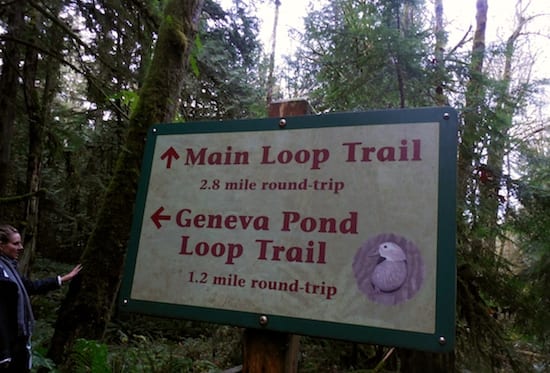Just outside of Bellingham, you'll find the Stimpson Family Nature Reserve a great location for trail running, walking, family hikes and exploring nature. The serenity of the place is spiritual- this is a great place (close to town) to get away and be connected with the outdoors. We set out for an afternoon stroll to see what all the hype is about.

"This park offers over 4 miles of hiking trails through a beautiful forest setting. The forest is largely undisturbed and displays characteristics of an old-growth forest, including Douglas fir trees over 400 years old, a wide diversity of tree species, snags and decaying logs, and a complex architecture of canopy, understory, shrub layer, and tapestry of the forest floor. Two ponds and additional wetland areas support a wide variety of plants and animals, including beaver. Deer, cougar, and smaller mammals frequent the park." Whatcom County Parks - Stimpson Family Nature Reserve
We chose to take the shorter route through the woods and follow the Geneva Pond Loop Trail with a 1.2 mile round trip to see what we could find.

As we walked through the forest we came to a sign that read, "Welcome to the Stimpson Family Nature Reserve. This reserve protects wildlife, water, and a rich forest ecosystem. Please enjoy this opportunity to learn about nature and to care for the land that we share. The Reserve includes the Lake Louise Natural Resources Conservation Area owned by the Department of Natural Resources, 196 acres owned by Whatcom Land Trust and 34 acres jointly owned by the City of Bellingham and Whatcom County. Whatcom County Parks & Recreation manages the Reserve, and Whatcom Land Trust maintains a permanent stewardship endowment for its upkeep. The core of the Stimpson Family Nature Reserve was donated to Whatcom land Trust in 2000 in memory of Edward K. and Catharine C. Stimpson by their seven children. This donation continues the family legacy of giving generously to our community."
As we meandered through the woods, the silence was interrupted briefly by the sound of trickling water. There are some spectacular water features that add another element while interrupting the deafening silence of this special place.

There is so much to soak in and catalog in the flora and fauna of the area, that I prefer to turn to the
Department of Natural Resources page that so succinctly identifies what you may experience OUT THERE in the reserve:
"Located near Bellingham, this 138-acre site has exceptional biological diversity, ranging from bogs and wetlands—including a large and very active beaver pond—to hardwood thickets and mixed conifer forests of Douglas-fir, western red cedar and western hemlock, some with old growth characteristics. Most conifer stands on the site originated around 1840. A few remnant large Douglas-fir trees are hundreds of years old. These trees, along with charcoaled snags and stumps scattered within the area, offer clues about the cultural and fire history in the area.

Some older trees and dead snags are inhabited by birds such as pileated woodpecker, hairy woodpecker, and brown creeper—which use cavities and decaying tree trunks for nesting. In the forested areas other wildlife can be seen—black-tailed deer, Douglas squirrel, mountain beaver, and a variety of birds, including varied thrush, golden-crowned kinglet, red crossbill, and red-breasted nuthatch.

The beaver pond, formed decades ago by the damming of Beaver Creek, supports a wetland of floating and emergent vegetation including yellow pond lily, duckweed, cattails, skunk cabbage, sedges, and rushes. The pond is used by a number of bird species. Red-breasted sapsuckers and hairy woodpeckers use the pond's snags for foraging. Wood ducks and hooded mergansers potentially can use the snags for breeding cavities. Emerging insects from the beaver pond provide food for violet-green swallows and barn swallows. Other species associated with the pond include osprey, belted kingfisher, and Virginia rail.
More than 300 species of fungi and slime molds have been identified by Fred Rhoades, a retired Western Washington University faculty member." (
WSDNR)
A trip into the reserve is well worth the short drive out of Bellingham city limits. We were especially amazed at the amount and variation of mosses (referenced above) that thrive in this bit of wilderness. It is a unique area that will be protected and there for us all to enjoy.

You can help protect the plant and animal life by minimizing disturbances. Please remember:
- Foot traffic only.
- Refrain from touching or removing plants, animals or historic artifacts.
- Observe wildlife without interrupting their activities.
- Pack it in; pack it out. Leave no trace of your visit.
Thank you." - Washington State Department of Natural Resources (sign)
Driving directions: From Bellingham, drive east, on Lakeway Drive (I-5 exit # 253). Follow the curvy main road which eventually becomes Cable Street. As it descends the last hill (Lake Whatcom in sight ahead) turn right onto Austin Street; this is the first right turn after the well marked pedestrian crossing. After a stop-sign, the street becomes Lake Louise Road. In about 1.5 miles look for the large trailhead parking lot on the left; be cautious of traffic when turning in. There is a local bus stop located directly across the road from the parking lot making this hike accessible with public transportation. (
WTA)






